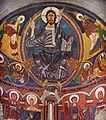
Romanesque architecture is an architectural style of medieval Europe that was predominant in the 11th and 12th centuries. The style eventually developed into the Gothic style with the shape of the arches providing a simple distinction: the Romanesque is characterized by semicircular arches, while the Gothic is marked by the pointed arches. The Romanesque emerged nearly simultaneously in multiple countries ; its examples can be found across the continent, making it the first pan-European architectural style since Imperial Roman architecture. Similarly to Gothic, the name of the style was transferred onto the contemporary Romanesque art.

A mosaic is a pattern or image made of small regular or irregular pieces of colored stone, glass or ceramic, held in place by plaster/mortar, and covering a surface. Mosaics are often used as floor and wall decoration, and were particularly popular in the Ancient Roman world.
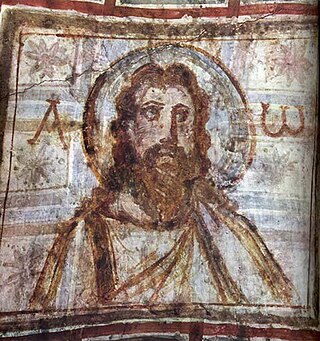
The depiction of Jesus in pictorial form dates back to early Christian art and architecture, as aniconism in Christianity was rejected within the ante-Nicene period. It took several centuries to reach a conventional standardized form for his physical appearance, which has subsequently remained largely stable since that time. Most images of Jesus have in common a number of traits which are now almost universally associated with Jesus, although variants are seen.

A tetramorph is a symbolic arrangement of four differing elements, or the combination of four disparate elements in one unit. The term is derived from the Greek tetra, meaning four, and morph, shape.

Sant Climent de Taüll, also known as the Church of St. Clement of Tahull, is a Roman Catholic church in Catalonia, Spain. It is an example of Romanesque architecture. Other influences include the Lombard and Byzantine styles, which can be seen throughout the exterior and interior of the building. The church is a basilica plan structure with three naves, each of them with a terminal apse, and large columns separating the side naves. Connecting to the church is a slim bell tower that has six floors plus a base. The artwork inside the church include the famous mural paintings by the Master of Taüll, as well as the wooden altar frontal. These works of art represent different aspects of Christianity that can also be found in many other works of art. The most famous fresco, of Christ in Majesty in the main apse of the church, has been moved to the Museu Nacional d'Art de Catalunya in Barcelona.

In Christian iconography, Christ Pantocrator is a specific depiction of Christ. Pantocrator or Pantokrator, literally ruler of all, but usually translated as "Almighty" or "all-powerful", is derived from one of many names of God in Judaism.
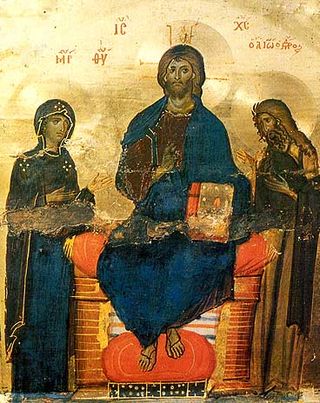
In Byzantine art, and in later Eastern Orthodox art generally, the Deësis or Deisis is a traditional iconic representation of Christ in Majesty or Christ Pantocrator: enthroned, carrying a book, and flanked by the Virgin Mary and St. John the Baptist, and sometimes other saints and angels. Mary and John, and any other figures, are shown facing towards Christ with their hands raised in supplication on behalf of humanity.

Romanesque art is the art of Europe from approximately 1000 AD to the rise of the Gothic style in the 12th century, or later depending on region. The preceding period is known as the Pre-Romanesque period. The term was invented by 19th-century art historians, especially for Romanesque architecture, which retained many basic features of Roman architectural style – most notably round-headed arches, but also barrel vaults, apses, and acanthus-leaf decoration – but had also developed many very different characteristics. In Southern France, Spain, and Italy there was an architectural continuity with the Late Antique, but the Romanesque style was the first style to spread across the whole of Catholic Europe, from Sicily to Scandinavia. Romanesque art was also greatly influenced by Byzantine art, especially in painting, and by the anti-classical energy of the decoration of the Insular art of the British Isles. From these elements was forged a highly innovative and coherent style.
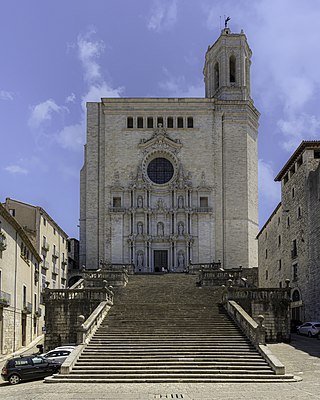
Girona Cathedral, also known as the Cathedral of Saint Mary of Girona, is a Roman Catholic church located in Girona, Catalonia, Spain. It is the seat of the Roman Catholic Diocese of Girona. The cathedral's interior includes the widest Gothic nave in the world, with a width of 23 metres (75 ft), and the second-widest of any church after that of St. Peter's Basilica. Its construction was begun in the 11th century in the Romanesque architectural style, and continued in the 13th century in the Gothic style. Of the original Romanesque edifice only the 12th-century cloister and a bell tower remain. The second bell tower was completed in the 18th century.

The Cathedral of Saint Lazarus of Autun, commonly known as Autun Cathedral, is a Roman Catholic cathedral in Autun and a national monument of France. Famous for its Cluniac inspiration and its Romanesque sculptures by Gislebertus, it is a highlight of Romanesque art in Burgundy. It is the seat of the Bishop of Autun. The Bishop of Autun set forth the construction of St. Lazarus Cathedral as a result of the large movement of pilgrims travelling to Vezelay as they progressed on the pilgrimage route to Santiago de Compostela.

Berzé-la-Ville is a commune in the Saône-et-Loire department in the region of Bourgogne-Franche-Comté in eastern France.

Early Christian sarcophagi are those Ancient Roman sarcophagi carrying inscriptions or carving relating them to early Christianity. They were produced from the late 3rd century through to the 5th century. They represent the earliest form of large Christian sculpture, and are important for the study of Early Christian art.

The Sarcophagus of Junius Bassus is a marble Early Christian sarcophagus used for the burial of Junius Bassus, who died in 359. It has been described as "probably the single most famous piece of early Christian relief sculpture." The sarcophagus was originally placed in or under Old St. Peter's Basilica, was rediscovered in 1597, and is now below the modern basilica in the Museo Storico del Tesoro della Basilica di San Pietro in the Vatican. The base is approximately 4 x 8 x 4 feet.

Italy has the richest concentration of Late Antique and medieval mosaics in the world. Although the art style is especially associated with Byzantine art and many Italian mosaics were probably made by imported Greek-speaking artists and craftsmen, there are surprisingly few significant mosaics remaining in the core Byzantine territories. This is especially true before the Byzantine Iconoclasm of the 8th century.
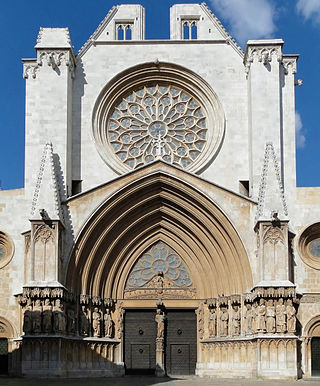
The Primatial Cathedral of Tarragona is a Roman Catholic church in Tarragona, Catalonia, Spain. The edifice is located in a site previously occupied by a Roman temple dating to the time of Tiberius, a Visigothic cathedral, and a Moorish mosque. It was declared a national monument in 1905.

The Ascension of Jesus to Heaven as stated in the New Testament has been a frequent subject in Christian art, as well as a theme in theological writings.

The Apse of Sant Climent de Taüll is a Romanesque fresco in the National Art Museum of Catalonia, Barcelona. The fresco is one of the masterpieces of the European Romanesque, from which the unknown Master of Taüll takes his name. It was painted in the early 12th century in the church of Sant Climent de Taüll in the Vall de Boí, Alta Ribagorça in the Catalan Pyrenees. The mural covered the apse of the church. In 1919-1923 it was moved, along with other parts of the fresco decoration, to Barcelona, in an attempt to preserve the murals in a stable, secure museum setting.

The iconostasis of the Cathedral of Hajdúdorog is the largest Greek Catholic icon screen in Hungary. It is 11 m tall and 7 m wide, holding 54 icons on five tiers. Creating such a monumental work of art requires a number of different craftsmen. Miklós Jankovits was hired by the Greek Catholic parish of Hajdúdorog in 1799 to carve the wooden framework, including the doors and the icon frames of the iconostasis. Mátyás Hittner and János Szűts could only start the painting and gilding works in 1808. The last icon was completed in 1816.
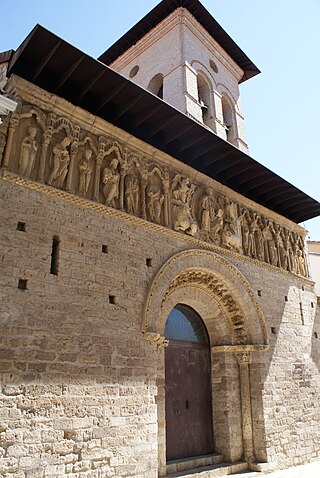
The Church of Santiago is located on the north-eastern corner of the main square of the town of Carrión de los Condes, Spain. The church stands on the main street that crosses the city following the Camino de Santiago and was built in the middle of the 12th century. It has suffered several alterations over the centuries, including a major fire in 1811, which have resulted in a mixture of architectural styles throughout the church. The western façade was built around 1160-1170 and is one of the culminating points of the Romanesque art in Spain.

The Tabán Christ is a 12th-century Maiestas Domini relief from Budapest. Originally part of a larger composition, the fragment is an important work of Romanesque sculpture from the territory of the medieval Kingdom of Hungary. The relief was discovered in a secondary position in the Church of Saint Catherine, the Baroque parish church of the Tabán neighbourhood in Buda. It has been located in the Budapest History Museum since 1952.









